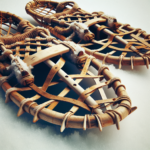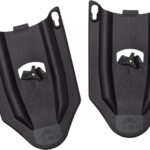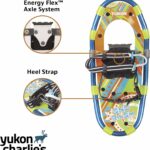Back in the day, people had some ingenious solutions for traversing the teeth-chattering cold of winter landscapes; one such invention was the humble snowshoe. In your journey through this article, you’ll discover the fascinating makeup of these classic winter tools. The materials used, the construction, and the reasons behind each material choice take center stage in this captivating exploration into the past. So, brace yourself for an engaging walk back in time as you uncover the secrets behind what snowshoes were made of in the past.
History of Snowshoes
You may not have thought much about the history of snowshoes, but these handy tools have a rich past that stretches back thousands of years. Whether used for hunting, transportation or just getting around in the snow, snowshoes played a pivotal role in the survival of many ancient cultures.
Origin of Snowshoes
Snowshoes aren’t modern inventions. Far from it actually. Their exact origins are mostly conjectures but the consensus among historians is they date back roughly 4000 to 6000 years, rooted in ancient Asia. Nomadic tribes living in snowy regions likely chanced upon the idea of creating a device that would help them tread easily over snow-covered terrain. They probably observed how certain animals with broad feet could walk on snow without sinking—an observation that kick-started the innovation of snowshoes.
Significance in Social and Cultural History
Snowshoes weren’t just practical; they became woven into the social and cultural fabric of societies. In snow-prone regions, mastering the art of making and using snowshoes was a rite of passage. They were vital for hunting in winter, for warriors preparing for battles, and for social activities like racing. Making snowshoes was often a communal task, involving detailed knowledge handed down through generations.
Evolution of Design Over Time
It’s fascinating how the design of snowshoes evolved over time as societies learned and adapted to changing environments. Early designs were likely rudimentary— wide and short, best-suited for hard-packed snow. As needs changed, so did designs, evolving into longer, narrower shapes for maneuvering through forests, and various bindings for better traction and control.
Ancient Materials Used in Snowshoe Construction
How did ancient people make these essential tools of survival? Believe it or not, the materials were all around them in nature!
Wood Types
The most commonly used material for the framework of snowshoes was wood. Specific types were favored for their strength and flexibility, like ash and birch. Using these woods, artisans would steam and bend them into the desired shape—a distinct, open framework that allowed for both support and ease of movement.
Animal Skins and Sinews
Animal materials played a crucial role in the construction of snowshoes. Skins, particularly moose and caribou, were used for bindings, while sinews—tough strands from animal tendons—were ideal for lacing the frames.
Plant Fibers
Both functionally and aesthetically, plant fibers made crucial contributions to snowshoe construction. Certain grasses, reeds, and bark were sometimes employed, adding durability and visual appeal.
Wooden Snowshoes
Wood, being readily available and durable, was the prime choice for the construction of snowshoes.
Selection of Wood
The selection of wood was crucial. Not all types of wood offered the perfect balance of flexibility and durability. Preferred were hardwoods like ash and birch, often harvested in spring when the sap was running, making them easier to bend.
Processing of Wood
Processing the wood was meticulous work. Strips were carefully peeled from the tree, smoothed till they were flexible, and then left to dry. Once dried, they could be bent using the steaming method— a process in which the wood’s dampened and gradually bent over a form until it takes on the desired shape.
Importance of Wood in Snowshoe Construction
Why was wood so important? Its pliability made it possible to create the wide, flat and curved frame characteristic of a snowshoe. Also, it could withstand the harsh winter conditions, maintaining its functionality while bearing significant weight.
Use of Animal Skins and Sinews
Animal skins and sinews weren’t just by-products of hunting, but important elements in crafting snowshoes.
Types of Skins Used
Selection of skins came down to durability. Moose and deer skins, known for their strength and resilience, were often the best choices. Not only did they serve as tough bindings, but they also perfectly complemented the wooden components.
How Skins Were Prepared
Preparing the skins was a meticulous yet necessary process. They were thoroughly cleaned, usually using an animal’s brain solution as a softening agent, scraped to remove all the fat and meat, then stretched and left to dry. This process gave the skins elasticity, strength, and durability required for the making of snowshoes.
Use of Sinew for Lacing
Sinew, usually from caribou or moose, played a critical role in lacing the snowshoes. This tightly wound tendinous material proved to be tough and stretchable, capable of handling the varying stresses exerted on the snowshoe.
Plant Fibers in Snowshoe Crafting
Final touches to the snowshoes were given using plant fibers, playing roles both decorative and functional.
Types of Plant Fibers Used
Many types of plant fibers like grasses, reeds, and bark were used, chosen for their durability, elasticity, and availability.
Preparation of Plant Fibers
Preparing plant fibers involved drying and weaving them into intricate designs. This required skill and patience, often resulting in beautifully crafted snowshoes.
Role of Plant Fibers in Crafting
Though seemingly decorative, these fibers improved the snowshoes’ binding strength and durability, while conferring a subtle beauty to the finished product.
Native American Snowshoes
Native Americans were instrumental in perfecting the art of snowshoe making, using available resources creatively and efficiently.
Different Tribes and their Snowshoes
Different tribes in North America had varying designs of snowshoes. Tribes located in dense forest areas typically made narrower snowshoes for easy maneuvering, while tribes in open tundra regions favored broad snowshoes, which were more suitable for traversing wide, flat landscapes.
Materials Used by Native Americans
Native American tribes used mostly available natural materials—wood for the frame, animal skins for bindings, and sinew for lacing. Nothing was wasted, and there was a deep appreciation for the resources nature provided.
Impact on Survival and Transportation
No question about it—snowshoes were essential to survival. They enabled hunting during the winter months, facilitated ease of transportation, and offered a means of escape in times of danger. Without them, thriving in harsh snow-bound environments would have been near impossible for these tribes.
European Influence on Snowshoes
Europeans brought their influence to bear on this indigenous technology, making changes both subtle and substantive.
European Introduction to Snowshoes
When European settlers first encountered snowshoes, they were not overly impressed. However, necessity forced them to adapt to the new conditions, eventually leading to the appreciation and adoption of snowshoes as an essential item for winter survival.
Changes Made by Europeans
Europeans made several changes to the traditional design. They introduced new materials, altered the size and shape for improved performance, and even mechanized the production process. These changes enabled mass production, thereby increasing accessibility.
Comparison to Native American Design
Despite all these changes, there remained a clear distinction between European and Native American designs. Native American snowshoes were handcrafted and tailored for specific conditions and purposes, while European models were often one-size-fits-all, designed for mass production.
Industrialization and the Shift to Synthetic Materials
The industrial revolution brought changes to every aspect of life, including the making of snowshoes.
Introduction of Synthetic Materials
The introduction of synthetic materials like plastic and metal was a game-changer. These materials, despite lacking in aesthetic appeal, had advantages—they were durable, could be mass-produced, and were significantly lighter than their wooden counterparts.
Impact of Industrialization on Craftsmanship
The industrialization of snowshoe production had a profound impact on craftsmanship. The mass production process meant lesser requirement for artisan skills, leading to a decline of the traditional snowshoe crafting techniques.
Current Trends in Snowshoe Materials
The use of traditional materials has seen a significant decrease in favor of synthetic materials due to their cheap cost, durability, and ease of manufacturing. However, there’s a resurgence in people seeking traditional designs, both for nostalgic and performance-related reasons.
Impact of Material Choice on Functionality
The choice of material has significant implications for both the functionality of the snowshoe and how it performs in different conditions.
How Material Affects Performance
The type of material used directly correlates with the performance and feel of the snowshoe. Traditional materials like wood may offer better floatation and feel more ‘natural’ underfoot, whereas synthetic materials often provide enhanced durability, lightness, and resistance to elements.
Choosing Material for Different Conditions
Just as a car tire must be suitable for the road conditions, so the material choice for a snowshoe must match the snow conditions. Hardwood designs are good for ‘deep snow’ conditions while synthetic designs are better for ‘packed snow’ conditions. Sometimes, a mix of both may be the best choice.
Significance of Material in Traditional vs. Modern Design
The significance of material choice is particularly highlighted when comparing traditional and modern snowshoes. Traditional snowshoes emphasize harmony with nature and durability, while modern designs focus more on performance, convenience, and mass production.
Preservation and Restoration of Historic Snowshoes
Given their rich history, preserving and restoring historic snowshoes is crucial for keeping the tradition alive and understanding our past.
Importance of Preserving Old Snowshoes
Preserving old snowshoes is not just about honoring history. It ensures the traditional knowledge, craftsmanship, and methods do not fade away with time. These artifacts provide insights into how our ancestors interacted with their environment, lived their lives, and built complex tools with limited resources.
Restoration Techniques
Restoring old snowshoes is a fine art requiring skilled hands. Techniques involve carefully removing old lacing, repairing any damage to the wooden frame, re-lacing with new sinew, and applying preservative finishes.
Display and Study of Historic Snowshoes
Displaying and studying historical snowshoes serve educational purposes, helping us appreciate the ingenuity of our ancestors. This is why you’ll often find antique snowshoes in museums, cultural centers, and even private collections.
In conclusion, snowshoes stand as testament to human innovation and resilience. Their story mirrors our own history, seamlessly interconnected with nature and endlessly adaptive. From their humble beginnings thousands of years ago to the high-tech creations of today, snowshoes continue to evolve, keeping step with our journey through time.
- What Snowboard Bindings Should I Get? - January 23, 2024
- What Size Screws For Snowboard Bindings? - January 23, 2024
- How To Snowmobile On Water? - January 23, 2024










